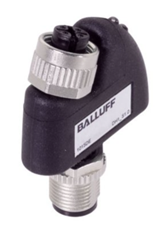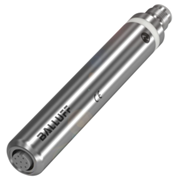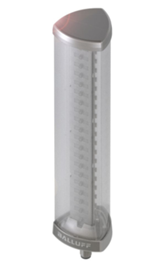Distributed IO-Link modules for efficient use of production space
Case study
Reading Time: minutes
Decentralisation of industrial automation systems is a growing trend, especially present in the manufacturing industry. See how the company TeamTechnik Polska used this idea to realise an assembly line project for a hybrid automatic transmission hydraulic module.
The basis of the innovation in the case of teamtechnik's customer was the use of Ballulff's IO-Link components for collecting signals from, among other things, sensors on the machines and the control panel. This solution was a response to the needs of machine builders in the fast-growing mobility industry, which is constantly looking for new ways to optimise production processes.
A stagnant situation
Until now, in a company cooperating with teamtechnik Poland, the handling of signals on the machine was done via passive hubs and multi-core connections to modules installed in control cabinets on the machine.
Operator panels were also organised on the same principle. Workers operated the panel buttons, which were connected to the machine's control cabinet via multi-core cables. There, too, was a decentralised system with passive input and output modules. Standard signal connections from the machine and the control panel were routed to them.
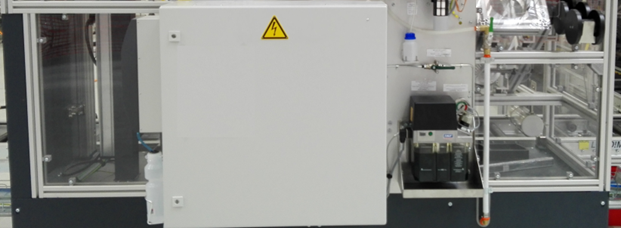 Standard control cabinet 600x600x300mm
Standard control cabinet 600x600x300mm
 Operator panel
Operator panel
Problem
The new line required an increase in machine space due to additional production components. The large number of components delivered in KLT containers combined with gravity roller feeders means less space for control cabinets, among other things. The challenge, therefore, was to minimize their size for installation on production stations.
The increased number of components and thus the increased number of controls while maintaining the size and ergonomics of the workstation operation did not allow for the classic approach with the current or enlarged cabinets. Thus, the main need was to make more space available on the workstation, which could be achieved by designing a layout with a smaller terminal cabinet and a new control system.
Solution
The idea that teamtechnik Poland came up with had to fit the specifics of manual stations, where there are now a large number of components picked up by the operator and many KLT containers in which all the components are transported to the operator. Such a system takes up a lot of space at the back of the work station, where container transport and logistics operations are managed. This rules out the use of a larger cabinet.
The solution turned out to be the use of Balluff decentralised solutions with IO-Link interfaces both for use on the machine and in the operator panel.
The task of the innovation was to reduce the amount of cabling routed to the cabinets and thus make the cabinets smaller, turning them into terminal cabinets. The space saved allowed the expansion of the line with new functionalities necessary for the production of a new, more complex product. How did this happen?
The goal of the operation was to minimise the cabinets, i.e. to go out to the machine with a decentralised layout by using Balluff IO-Link modules. The control of the operator panel has also changed - the aforementioned pushbuttons, which were previously connected by multi-core cables to the control cabinet, have now also been plugged into the IO-Link network.
Teamtechnik Polska dealt with the control issue by introducing Balluff's IP20 IO-Link distributed modules into the control cabinet. This made it possible to reduce the size of the cabinet tenfold, which finally reached 300x400x120mm. After the innovation, it contains only terminals for power supply on the machine and collecting individual signals from the machine.
This kind of project demonstrates perfectly the benefits provided by a distributed approach to machine building. Then signals are collected where they arise - without the need to send them to a central cabinet. We can still talk about a modern solution in this case, subject to gradual popularisation. In addition, the emergence of new modules and signal converters that work with IO-Link networks is causing more companies to find value in decentralisation, and this is the direction Industry 4.0 seems to be heading.
How does it work?
The solution used manages the digital signals from operator control panel buttons and lights. Through the Balluff BNI004L and BNI004K input/output modules used, it transmits information via the IO-Link protocol to the Balluff BNI00HL master. Similarly, the collection of signals from sensors on the machine takes place, which through the BNI003U input/output modules also go to the BNI00HL IO-Link bus module.
Analogue signal converters BNI0041 were also successfully used, where information from existing analogue sensors are fed into IO-Link masters. Further components used in the decentralised system are. BNI00C1, which are RS232 to IO-Link signal converters used to connect barcode scanners used on the production line to identify components. To complete the circuit, SmartLight signal columns were used BNI0072 with IO-Link communication allowing individual configuration of 5 independent light segments. In this way, the collection of signals on the machine goes to the IO-Link bus masters, and then these signals reach the PLC via Profinet communication.
The PLC uses the complete information from sensors, buttons and scanners during sequential operation of the machine by controlling its movements and signaling the operation status with a light column. Thus, the multiplicity of Balluff solutions in the IO-Link system allowed comprehensive handling of signals directly on the machine.
 Balluff BNI004L and BNI004K modules assembled in a control panel
Balluff BNI004L and BNI004K modules assembled in a control panel
 Balluff BNI00HL modules mounted on the machine
Balluff BNI00HL modules mounted on the machine
BNI0041 analogue signal converters are also successfully used, where information from analogue sensors are fed into IO-Link masters. Further components used in the decentralised system are BNI00C1, which are RS232 to IO-Link signal converters used to connect barcode scanners, which are used on the production line to identify components. To complete the layout, SmartLight BNI0072 signal columns with IO-Link communication were used, allowing individual configuration of 5 independent light segments. In this way, the collection of signals on the machine goes to the IO-Link bus masters, and then these signals reach the PLC via Profinet communication.
The PLC uses a set of information from sensors, pushbuttons and scanners during sequential operation of the machine by controlling its movements and signaling the operation status with a light column. Thus, Balluff's multiple solutions in the IO-Link system allowed for comprehensive signal handling directly on the machine.
Customer benefits
The use of the Balluff IO-Link solution of decentralised masters, hubs, converters and light columns made it possible to:
-
reduce the control cabinet several times, i.e. go down to 300x400x120mm in size from the previous 600x600x300mm and 800x600x300mm. The volume of the current cabinet is 0.0144m3, and the previous ones were 0.108m3 or 0.144m3 (i.e., up to 10 times smaller in volume)
-
simplify the installation of control cabinets by bringing them down to the level of terminal cabinets
-
reduce the number of multicore cables by using IO-Link communication, thereby reducing the number of possible mistakes during wiring installation and simplifying any subsequent service work
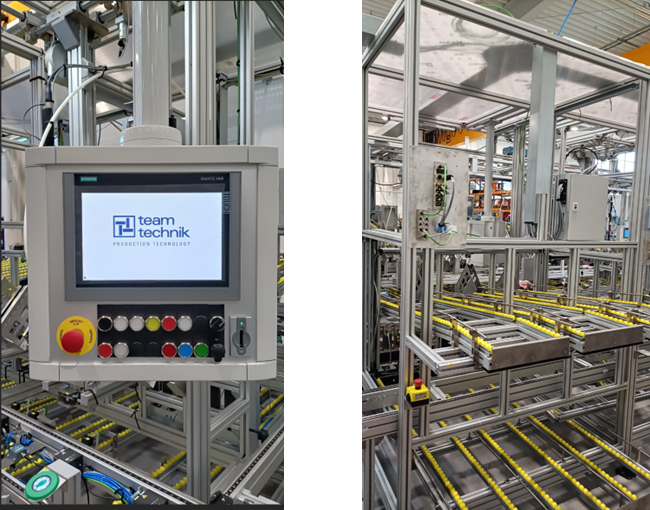 New assembly station with Balluff IO-Link modules used and a small terminal cabinet
New assembly station with Balluff IO-Link modules used and a small terminal cabinet
The customer's greatest success in this case is the space savings on the shop floor. The use of larger cabinets would have required building the machine elsewhere. The space designated for building the machine was limited. For ergonomic reasons, it would not have been possible to stack a large number of components on one station.
Getting rid of a large amount of wiring is also a benefit of easier servicing and more convenient diagnostics. Standard IO-Link connections mean prefabricated cables instead of multi-core wiring. Instead of searching for the cause of problems with a meter in the control cabinet, workers can get to the source of the problem via Ethernet ports and diagnose the problem right on the machine in question. This translates directly into shorter downtime during failures.
The action of teamtechnik Polska was to tailor the solution to the customer's particular situation consisting of a specific hall area and a specific production line design. It turned out to be a success to understand the problem and select the components in such a way that the project could be realised and meet the set requirements.
About the company
Teamtechnik Production Technology Ltd. is one of the world leaders in innovative production technologies and fully flexible assembly and test lines. The company's goal is to design and disseminate innovative automation solutions that meet the requirements and needs of our customers in the mobility, industrial goods and life science industries. Special attention is paid to a high level of expertise in software and control technology.
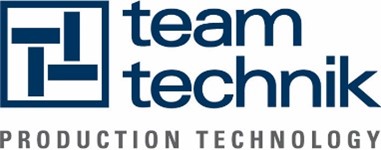
Keywords
- Case Study
Author
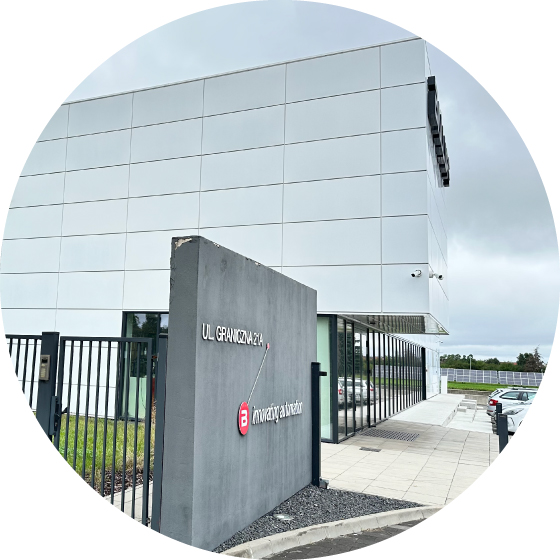
Balluff Sp. z o.o.
We have been active on the Polish market for more than 25 years. We serve our customers from Pomerania to the Tatra Mountains, providing first-class service and technical support. We are also present online, where we share our knowledge about the latest implementations, industry trends, events or technical aspects of our solutions.
41 Contributions
Comment
Popular posts
What is a capacitive sensor?
How do I wire my 3-wire sensors?
Industrial sensing fundamentals – NPN vs PNP
The industrial revolution - from the steam engine to Industry 4.0
Contact form
Do you have any questions or suggestions? We are at your disposal.
Balluff Limited
-
20 Cheshire Business Park
Cheshire Avenue
Lostock Gralam
Northwich, CW9 7UA

